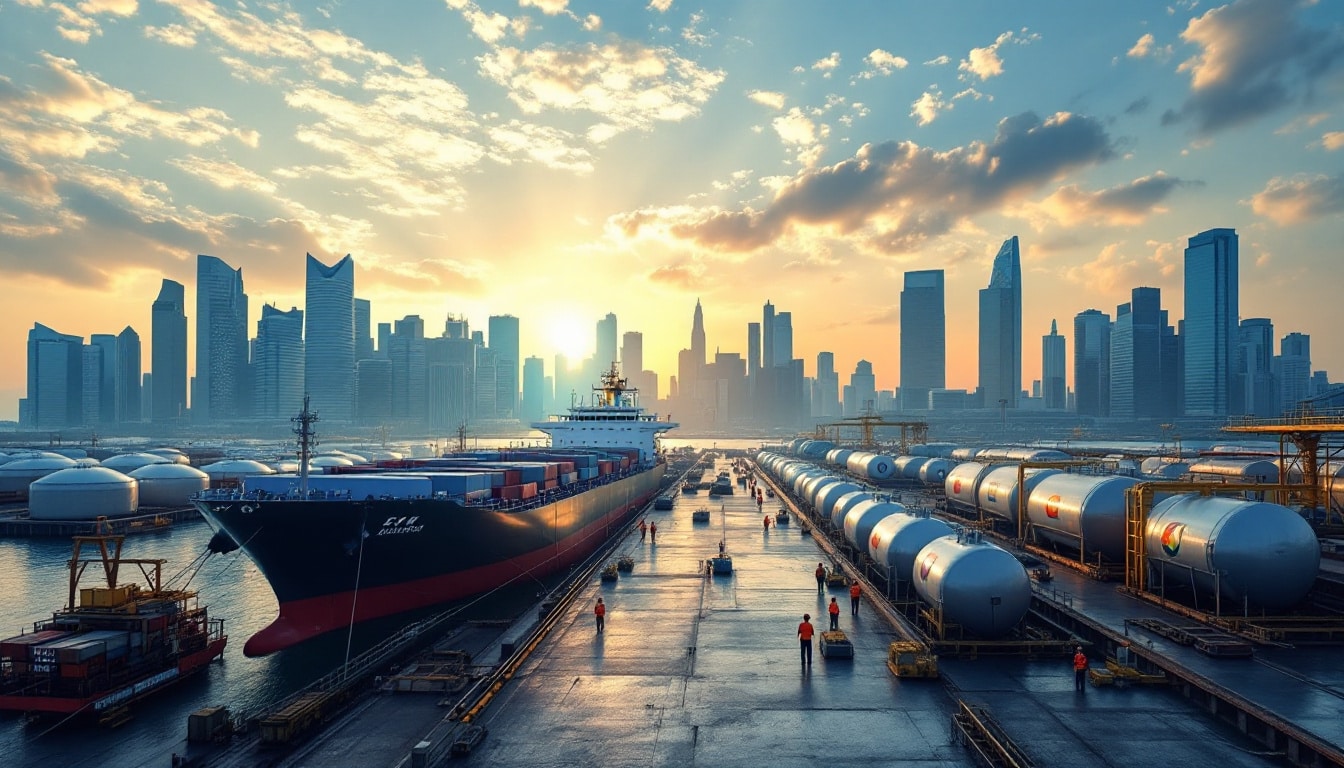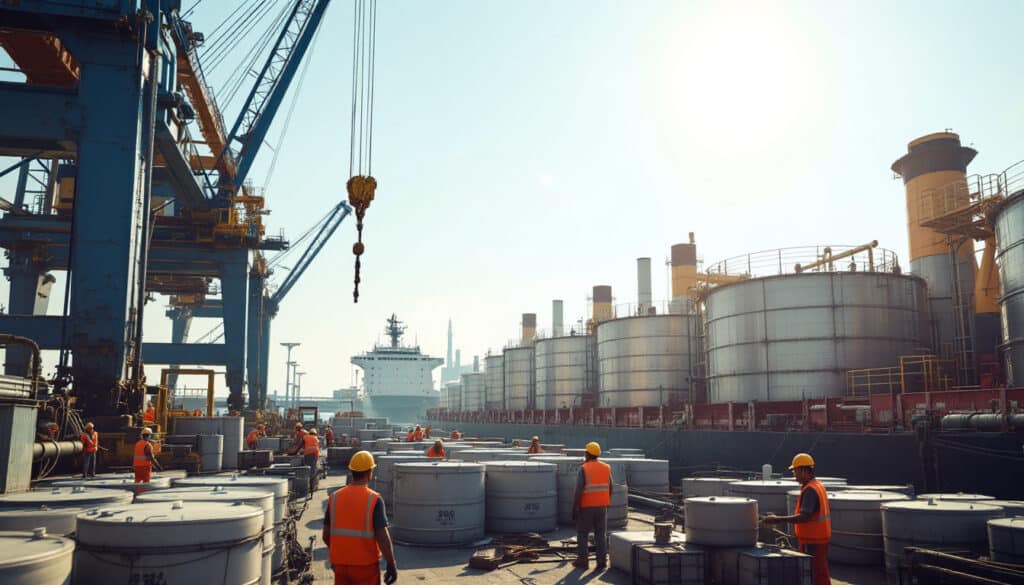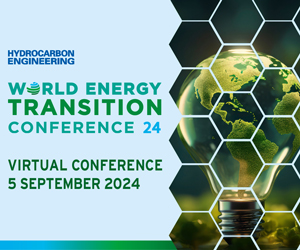Singapore is establishing itself as a vital hub for bunker fuel, solidifying its status as a global center for maritime energy. With forecasts indicating an exceptional growth of 14.2% by 2033, Singapore’s bunker fuel market is attracting the attention of industry players and investors from around the world. The strategic positioning of the city-state, combined with favorable regulations and world-class port infrastructure, plays a key role in this dynamic.
As maritime trade regains momentum, the sales of bunker fuel in Singapore continue to thrive, representing 20% of the global bunkering market. Constant innovations, such as the increasing use of LNG and biofuels, are also part of the evolving landscape. The Port of Singapore Authority is at the forefront, actively exploring sustainable solutions tailored to the demands of the IMO 2020. In this context, the bunker fuel market in Singapore is more than just a business opportunity; it embodies the future of sustainable navigation and renewable energies at sea.
The bunker fuel market in Singapore represents a strategic sector in the maritime industry, positioning itself as a global leader thanks to its advanced infrastructure, clear regulations, and commitment to sustainable bunkering methods. According to recent forecasts, the size of this market is expected to exceed 256 billion dollars by 2033, with a compound annual growth rate (CAGR) of 2.62% from 2023 to 2033. Singapore, as a fundamental maritime crossroads, represents about 20% of the global bunkering market, attesting to its undeniable importance.
Table of Contents
ToggleGrowth Factors: Towards an Energy Revolution
Several elements combine to make Singapore an essential hub in the bunker fuel sector. One of the recent motivations for this growth comes from the implementation of regulations from the International Maritime Organization (IMO) in 2020, which aim to reduce sulfur emissions from marine fuels. This regulation encourages shipping companies to adopt cleaner fuels, thereby increasing the demand for sustainable solutions, such as liquefied natural gas (LNG) and biofuels.
For example, the first delivery of biofuel bunker in Singapore was carried out by TotalEnergies Marine Fuels in collaboration with Hapag-Lloyd and Jurong Port Universal Terminal. This pioneering step demonstrates Singapore’s commitment to exploring greener transport options and addressing the growing expectations of maritime companies eager to reduce their carbon footprint.
Key Players and Their Impact on the Market
The bunker fuel market in Singapore is energized by several major players, including Petrochina International, Sentek Marine & Trading Pte Ltd, and Ocean Bunkering Services. These companies play a crucial role in providing innovative solutions tailored to the diverse needs of mariners. For instance, the initiative by CMA CGM, which equipped the container ship CMA CGM SCANDOLA with the first LNG refueling in Singapore, is a major example of innovation illustrating the growing trend towards the use of alternative fuels.
The market players are not only developing business models aligned with sustainability, but they are also investing in modern infrastructure to support efficient bunkering logistics. The Maritime and Port Authority of Singapore (MPA) is implementing ambitious plans to enhance bunkering capacity and the safety of facilities, thus ensuring reliable and high-performing service for all vessels.
The establishment of advanced fuel tracking systems and the digitization of operations also improve transparency and traceability of supplies. This meets not only regulatory requirements but also the growing expectations of customers for responsible and sustainable practices.
Challenges to Overcome for a Sustainable Future
Despite its successes, the bunker fuel market in Singapore faces several challenges. The transition to greener fuels requires significant investments in research and development, as well as in the infrastructure needed to distribute these new types of fuels. Moreover, fluctuations in raw material prices and increasing competition from neighboring ports pose additional obstacles.
Companies must also navigate a constantly evolving regulatory environment. Adapting to increasingly stringent emission and sustainability standards may require complex strategies and the implementation of innovative technologies. These challenges, while significant, also open the door to new opportunities for market players with the vision and resources necessary to innovate.
A proactive approach is essential to anticipate market changes. Companies must integrate sustainable management practices to optimize their operations, including recycling programs and energy conservation initiatives. Collaboration with government agencies and NGOs can also help shape a more sustainable maritime future while strengthening trust relationships with stakeholders.
Conclusion: The Future of Bunker Fuel in Singapore
Singapore, with its status as a leader in the bunker fuel market, continues to evolve towards a sustainable and innovative future. The commitment to sustainability, combined with strategic investments in infrastructure and technology, promises to bolster Singapore’s position as a global maritime energy hub. By integrating alternative fuels and championing responsible practices, Singapore is laying the groundwork for a safe, competitive, and sustainable maritime future.

FAQ on the Bunker Fuel Market in Singapore
What is the expected size of the bunker fuel market in Singapore by 2033? The size of the bunker fuel market in Singapore is expected to represent a significant share by 2033, with a growth of 14.2% between 2023 and 2033.
How is the global bunker fuel market developing? The global bunker fuel market is expected to exceed 256 billion dollars by 2033, with a CAGR of 2.62% from 2023 to 2033.
What are the reasons for the increase in the bunker fuel market in Singapore? Singapore is experiencing a strong increase in the bunker fuel market due to the IMO 2020 regulations and the recovery of global maritime trade.
Which companies dominate the bunker fuel market in Singapore? Key players in Singapore’s bunker fuel market include Petrochina International, Sentek Marine & Trading Pte Ltd, and Ocean Bunkering Services (Pte) Ltd.
What symbolic event recently took place in the bunkering field in Singapore? The CMA CGM SCANDOLA is the very first container ship to be refueled with LNG in Singapore, marking a turning point in the use of sustainable energy sources.
What initiatives are being explored by the Port Authority of Singapore? The Port Authority of Singapore is exploring opportunities to develop its LNG bunkering services, thereby strengthening its position as a maritime hub.
What notable collaborations have recently taken place in fuel supply in Singapore? TotalEnergies Marine Fuels, Hapag-Lloyd, and Jurong Port Universal Terminal recently launched the first delivery of biofuel bunker in Singapore, illustrating the commitment to sustainable energy solutions.









